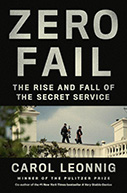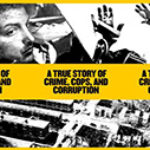Zero Fail: The Rise and Fall of the Secret Service

Author: Carol Leonnig
Publisher: Random House, 2021. 532 pages
Reviewer: Rhodri Jeffreys-Jones ǀ November 2021
Zero Fail has the characteristics of a book written by a journalist who is a triple Pulitzer Prize-winner. Its author, Carol Leonnig, writes for the Washington Post. Her prose is truly gripping, having that impossible-to-put-down quality that is the dream of every publisher and literary agent. It carries a great deal of dialog and is an intoxicating procession of anecdotes that reflect the author’s diligent research — research that includes her oral history interviews of some of her story’s main characters.
Leonnig applies a certain recipe consistently throughout Zero Fail. She tells of the relationships between a succession of presidents and the men (and in recent years women) of the Secret Service. She relates the dangers faced by presidents, their families, and others who were offered the protection of the Service. As one would expect, she focuses on assassination attempts. She starts her main storyline with the one presidential fatality of the modern era. The Secret Service underwent expansion in response to the John F. Kennedy (JFK) assassination. Although its “rise” was matched by a “fall” from grace in due course, it would lose no more chief executives in the decades to 2021, the year of her book’s publication. In chronicling the “fall”, our author supplies salacious details on the sexual misadventures of Service agents. These passages are balanced by details of presidential misconduct, so the book brims with sex.
JFK received three times as many threats to his life as the previous average and was protected by a detail of “just” 34 agents (p. 6). Leonnig consistently accepts the claims of Service bosses that the agency was understaffed – in the Kennedy presidency, the Service had 300 agents overall, compared with 7,000 today. The young president was “reckless” (p. 21) in his determination to court public popularity by mixing with crowds. His dalliance with a “steady parade” of sexual partners made him a security nightmare. A “sea of random women” entered the White House to service his lust (p. 24). There was no way that the Service could check on their security backgrounds. However, his death, when it came in Dallas in 1963, arguably reflected not his own weaknesses but the Service’s deficiencies. Computerizing the list of would-be assassins should have happened before, not after Lee Harvey Oswald was able to line up his fatal shots. Agents accompanying the presidential cavalcade at the time of the shooting may have reacted a split second too slowly. For when the Warren Commission “lashed” the Secret Service for its ineptitude in Dallas, it did so partly on the ground that agents had been drinking heavily into the small hours. Yet the Service’s punishment would be, and Leonnig applauds it, a reward – it was authorized to increase its force of agents by fifty percent.
Leonnig relates how Governor George Wallace was shot and paralyzed in spite of the fact that, as a presidential candidate in 1972, and on the orders of President Lyndon B. Johnson from 1968, he had Secret Service protection. To boost his already strong chances of being re-elected in 1972, President Richard Nixon wanted to pin the Wallace attack on supporters of his Democratic opponent, Senator George McGovern. Lacking evidence, Leonnig writes, he engaged the former CIA officer E. Howard Hunt to manufacture it for him. Nixon, Leonnig laments, contributed to the tainting of the Secret Service – infamously, he required it to pay for some domestic interior decoration. She argues, further, that Nixon encouraged his elite protective patrol “to adopt his model of distrust and arrogance with outsiders” (p. 113).
In 1981, John W. Hinckley shot President Ronald Reagan outside a Washington, D.C. hotel in an attack that had no fatal consequence, yet posed a question about the Service’s ability to defend the nation’s chief executive. Leonnig’s account of this is an example of journalistic style at its supreme best. Yet she shows a remarkable lack of curiosity about Hinckley, about what happened to him (he was detained as criminally insane until 2016), and about how a person with his mental instability got his hands on a rapid-firing gun with expanding “dumdum” bullets.
Neither does Leonnig inquire how John Spencer Daughertee, a paranoid schizophrenic who heard voices compelling him to kill a president, obtained a .38 caliber handgun with the intention of assassinating President George H. W. Bush in a township outside Detroit in 1989. She does make the point that Bush was cautious about his safety and had better relations with the Service than any other president before or since – perhaps these were factors helping to explain Bush’s ultimate survival.
At the time of the Monica Lewinsky scandal, presidential sexual indiscretion again became an issue. In spite of the supposed casualization of sex since the 1960s, it transpired that a deep vein of puritanism remained in American politics, and President Bill Clinton’s partisan opponents made the most it. Leonnig relates that when ABC News aired its “Camelot” program on 4 December 1997, reminding the nation of JFK’s lack of character, President Clinton began to panic. In the subsequent inquiry, Larry Cockell, a Black man who had been in charge of the White House Secret Service detail, refrained from satisfying Clinton’s enemies with gratuitous information about his female visitors. In reminding us of these details, Leonnig abstains from any profound speculation about the Service’s lack of information on the security background of visitors to the Clinton White House.
President-elect Obama attracted a torrent of racist threats. In Leonnig’s estimate, he would subsequently be “the most endangered president in history” (p. 275). He survived two terms, but the reputation of the Secret Service plummeted. Black agents complained of maltreatment and there were instances of overt racism within the agency. For example, Secret Service personnel suspended a noose for the purpose of intimidating one Black agent. As if this were not enough, the Obama administration had to contend with the Cartegena “hookergate” affair of April 2012: some of the 175 agents sent to protect Obama during a visit to Colombia were caught red-handed when they went on an orgy of drinking and sex with prepagos, or prepaid prostitutes.
The Secret Service bigots who disapproved of Obama, and equally of Hilary Clinton, found a soul mate in Donald Trump. In flagrant violation of the Hatch Act, “clusters” of agents openly “rooted for Trump” and sympathized with the lawbreakers who stormed the Capitol to protest and frustrate the result of the 2020 presidential election (p. 483). The Secret Service refused to supply Joe Biden and his family with protection after Biden’s electoral victory, breaking with tradition on the ground that his election, in being challenged by the Trumpite cohorts, was unconfirmed. Failure to authorize the cover rested with the outgoing president of the United States, but one wonders why the director of the Secret Service did not see fit to resign over this issue.
Considered as a work of history, Zero Fail suffers from a number of deficiencies. One of these is scant regard for historical context. The book briefly surveys the period from President Abraham Lincoln’s establishment of the Secret Service in 1865 to the assassination of his successor JFK almost a century later, but Leonnig has neither read nor thought deeply about issues through what was, after all, the bulk of the Service’s existence. She emphasizes the anti-counterfeiting activities of the Service, still part if its remit today. But she mentions only in passing the Service’s successful war on the Ku Klux Klan in the 1870s, and fails entirely to note that this set the conservative white South against the agency – the states’ rights issue and fears of federal tyranny been one of the main impediments to the Service’s expansion — impediments that Leonnig deplores but does not satisfactorily explain.
Similarly, Leonnig finds no space to discuss the Service’s impressive counter-espionage role in the War of 1898 and then World War I, and the significance of the Service’s subsequent demotion to be mainly a protection agency. Moreover, she lists pre-1961 assassination events and attempts, but makes no effort to justify her assumption that JFK’s demise changed the Service’s universe, whereas the deaths of Presidents Lincoln, James Garfield and William McKinley did not. And if the attempt on Wallace’s life deserves full treatment whereas that on Theodore Roosevelt’s receives no more than a passing mention, we need to know the reason why. This lack of cogitation indicates a lack of curiosity about major problems such as the relative propensity of Americans to violence (or not, as the case may be), the whole, fraught, availability-of-guns issue, and the question, what made assassins tick?
On the last point, Leonnig does refer to the Secret Service’s “exceptional case study project” of May 1997, entitled Preventing Assassination, thus at least giving the reader a steer toward further information. That study offers a profile of 83 actual and would-be attackers, 1949-1996, concluding that the typical American assassin is attention-seeking, mentally ill, and apolitical. But Leonnig is not driven to advance interpretations of her own or to ask difficult questions, such as that about potential psychological or moral-equivalence links between assassination as an instrument of foreign policy (the plans to kill Fidel Castro, the anti-Viet Cong “pacification” program, the use of drones in non-combat areas), and murderous intentions closer to home.
The author should, perhaps, have taken a firmer line with the copywriter who stated on the dustjacket of her volume that the Secret Service’s “story begins in earnest in 1961.” She is more careful with her own prose, and Zero Fail should not be dismissed as just a cornucopia of trivia. For if, on the one hand, it is an infectious work of entertainment, on the other hand it is a detailed and reliable narrative of the contemporary history of the Secret Service, something that has not previously been attempted.
Leonnig is highly critical of the Secret Service, and even compares it with the Mafia – as in the case of la Cosa Nostra, she notes, its corrupt promotions system culminates in ambitious candidates being “made” (p. 484). She balances her remarks with moving tributes to the bravery of individual Service agents who, sometimes literally, threw their bodies between approaching bullets and their intended target, the President of the United States. Her goal was to write a book that will prompt reform of one of America’s essential agencies, and thinks that it was her aspiration to improve the Service that persuaded agents she interviewed to talk to her freely. Legislators on Capitol Hill usually have too many distractions to pay heed to the appearance of an individual book. But they would be wise to consider what Carol Leonnig has to say.
Rhodri Jeffreys-Jones is professor emeritus of American history at the University of Edinburgh.


